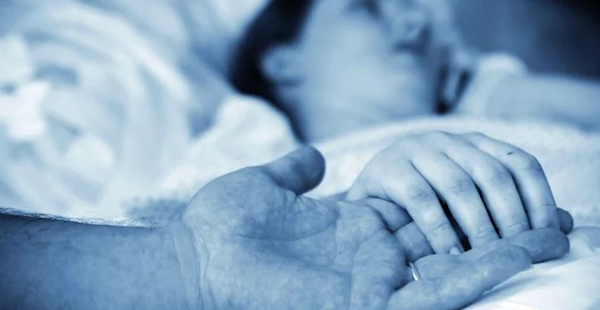What to expect and how to respond to the natural dying process
[N]o one can predict the moment of death. But physicians and nurses involved in end-of-life care know that certain symptoms are usually associated with the body’s shutting down. These signs of approaching death are specific to the natural dying process (apart from the effects of particular illnesses the person may have).
Not all dying symptoms show up in every person, but most people experience some combination of the following in the final days or hours:
1. Loss of appetite
Energy needs decline. The person may begin to resist or refuse meals and liquids, or accept only small amounts of bland foods (such as hot cereals). Meat, which is hard to digest, may be refused first. Even favorite foods hold little appeal.
Near the very end of life, the dying person may be physically unable to swallow.
How to respond: Don’t force-feed; follow the person’s cues even though you may be distressed by a loss of interest in eating. Periodically offer ice chips, a popsicle, or sips of water. Use a moistened warm cloth around the mouth and apply balm to the lips to keep them moist and comfortable.
2. Excessive fatigue and sleep
The person may begin to sleep the majority of the day and night as metabolism slows and the decline in food and water intake contribute to dehydration. He or she becomes difficult to rouse from sleep. The fatigue is so pronounced that awareness of immediate surroundings begins to drift.
How to respond: Permit sleep. Avoid jostling the person awake. Assume that everything you say can be heard, as the sense of hearing is thought to persist, even when the person is unconscious, in a coma, or otherwise not responsive.
3. Increased physical weakness
A decline in food intake and lack of energy leads to less energy, even for activities like lifting one’s head or shifting in bed. The person may even have difficulty sipping from a straw.
How to respond: Focus on keeping the person comfortable.
4. Mental confusion or disorientation
Organs begin to fail, including the brain. Higher-order consciousness tends to change. “Few conditions leave people hyperaware when they’re dying,” says palliative-care physician Ira Byock, author of Dying Well.
The person may not be aware of where he or she is or who else is in the room, may speak or reply less often, may respond to people who can’t be seen in the room by others (see Passing Away: What to Expect When Witnessing a Loved One’s Death), may seem to say nonsensical things, may be confused about time, or may act restless and pick at bed linens.
How to respond: Remain calm and reassuring. Speak to the person softly, and identify yourself when you approach.
5. Labored breathing
Breath intakes and exhales become raggedy, irregular, and labored. A distinctive pattern called Cheyne-Stokes respiration might be heard: a loud, deep inhalation is followed by a pause of not breathing (apnea) for between five seconds to as long as a full minute, before a loud, deep breath resumes and again slowly peters out.
Sometimes excessive secretions create loud, gurling inhalations and exhalations that some people call a “death rattle.”
How to respond: The stopped breathing or loud rattle can be alarming to listeners, but the dying person is unaware of this changed breathing; focus on overall comfort. Positions that may help: the head slightly elevated with a pillow, sitting up well-supported, or the head or lying body tilted to the side slightly. Moisten the mouth with a wet cloth and moisturize with lip balm or petroleum jelly.
If there’s a lot of phlegm, allow it to drain naturally from the mouth, since suctioning it out can increase its quantity. A vaporizer in the room might help. Some people are given oxygen for comfort. Be a calm, physical presence, stroking the arm or speaking softly.
Complete Article ↪HERE↩!

